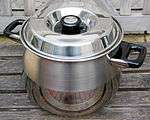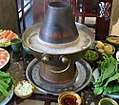鍋
See also: 锅
| ||||||||
Translingual
Han character
鍋 (radical 167, 金+9, 17 strokes, cangjie input 金月月口 (CBBR), four-corner 87127, composition ⿰金咼)
References
- KangXi: page 1313, character 10
- Dai Kanwa Jiten: character 40603
- Dae Jaweon: page 1814, character 6
- Hanyu Da Zidian: volume 6, page 4220, character 6
- Unihan data for U+934B
Chinese
| trad. | 鍋 | |
|---|---|---|
| simp. | 锅 | |
Glyph origin
| Characters in the same phonetic series (冎) (Zhengzhang, 2003) | |
|---|---|
| Old Chinese | |
| 碢 | *l'oːl |
| 腡 | *ɡ·roːl, *kʷroːl |
| 過 | *kloːl, *kloːls |
| 渦 | *kloːl, *qloːl |
| 鍋 | *kloːl |
| 楇 | *kloːl, *ɡloːls |
| 瘑 | *kloːl |
| 緺 | *koːl, *kroːl, *kʷroːl |
| 堝 | *kloːl |
| 濄 | *kloːl, *qloːl |
| 鐹 | *kloːlʔ, *kloːls |
| 薖 | *kʰloːl |
| 簻 | *kʰloːl, *kr'oːl |
| 禍 | *ɡloːlʔ |
| 窩 | *qloːl |
| 萵 | *qloːl |
| 檛 | *kr'oːl |
| 膼 | *kr'oːl |
| 蝸 | *kroːl, *kʷroːl |
| 媧 | *kroːl, *kʷroːl |
| 騧 | *kroːl, *kʷroːl |
| 冎 | *kroːlʔ |
| 剮 | *kroːlʔ |
| 諣 | *qʰroːls, *qʰʷroːls |
| 歄 | *kʷroːl |
| 咼 | *kʰʷroːl |
| 喎 | *kʰʷroːl |
Phono-semantic compound (形聲, OC *kloːl) : semantic 金 (“metal”) + phonetic 咼 (OC *kʰʷroːl).
Etymology 1
Pronunciation
Definitions
鍋
- pot
- (Mainland China, neologism) This term needs a translation to English. Please help out and add a translation, then remove the text
{{rfdef}}.
Compounds
Derived terms from 鍋
|
|
|
Japanese
Etymology
 鍋: traditional nabe (both the pot and the food) |
 |
 | |
 スープ鍋 (sūpu nabe): a soup pot or stockpot |
| Kanji in this term |
|---|
| 鍋 |
| なべ Grade: S |
| kun’yomi |
Originally a compound of Old Japanese elements 肴 (na, “small snack, hors d'oeuvre”) + 瓮 (he, “a pot or pan for holding food or beverages”). The he changes to be as an instance of rendaku (連濁).
Noun
Related terms
Descendants
- Korean: 냄비 (naembi, “pan, saucepan; pot”)
See also


Korean
Hanja
鍋 • (gwa) (hangeul 과, revised gwa, McCune–Reischauer kwa, Yale kwa)
- This term needs a translation to English. Please help out and add a translation, then remove the text
{{rfdef}}.
Vietnamese
Han character
鍋 (oa)
- This term needs a translation to English. Please help out and add a translation, then remove the text
{{rfdef}}.
This article is issued from
Wiktionary.
The text is licensed under Creative
Commons - Attribution - Sharealike.
Additional terms may apply for the media files.
